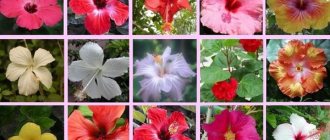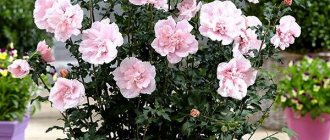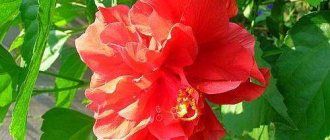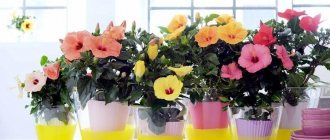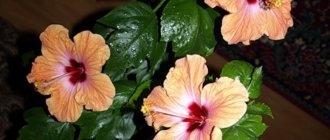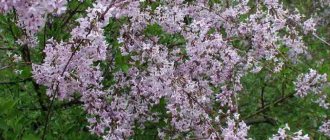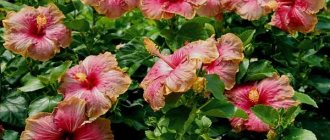Chinese hibiscus (Hibiscus rosa-sinensis), also called Chinese rose, is the most popular species of the Hibiscus genus of the Malvaceae family among gardeners. The genus of hibiscus includes approximately 200 species, but the most popular in culture is the Chinese rose. The homeland of this plant is the northern part of Indochina and southern China.
It was from there that the flower spread throughout the tropical and subtropical regions of planet Earth. This plant is so loved by flower growers and gardeners that, for example, in Malaysia it is considered one of the symbols of the country, and it is also depicted there on coins. By the way, there they call him Bungaraiya. In places where climatic conditions are not suitable for cultivating such a flower in the garden, it is grown indoors or in greenhouses.
Short description
Chinese rose, Hibiscus, Indoor rose, Sudanese rose, Red sorrel, Chinese rose - that's how many names this beautiful plant of the Malvaceae family has. There are about 300 species of this flower in the world, but not all varieties are grown indoors.
- In Europe, hibiscus was seen only in the 18th century. It grew in greenhouses and was an Asian tropical wonder plant with beautiful flowers that looked like large funnels. In the wild it is presented in the form of trees and shrubs.
- Only many years later did breeders develop varieties for indoor cultivation. And since then, Rozan Chinese has firmly entered the top 10 leaders popular among flower growers.
- There are many types and varieties. Therefore, you can find hibiscus not only as a tree or shrub form, but also as a herbaceous plant. It can be deciduous and evergreen.
- Rosan branches are sometimes found covered with smooth bark, but they are also slightly pubescent. The flowers reach a circumference of 15 - 16 cm.
- Their structure is often simple, but the most beautiful are the double and semi-double varieties. The color scheme is very diverse: scarlet and red, raspberry-pink and soft yellow, with contrasting veins and uniform color of the petals. They form and grow on the upper parts of the stems.
- Many flower growers know that this plant has a positive effect on a person’s health, and almost all flowers feel great next to hibiscus.
The flower is undemanding. The main thing that needs to be taken into account first is timely pruning, then the flowering will be gorgeous. But first things first.
Popular indoor varieties and their photos
White
Hibiscus rosa-sinensis “Lady Stanley” is a variety with semi-double white-pink flowers. Blooms from June to August. Due to prolonged drought, it may bloom later.
Read everything you need to know about white hibiscus - varieties, cultivation, care features - in this material.
Red
The variety Hibiscus rosa-sinensis “Gamburg” has large , double flowers of bright cherry-red color.
Pink
Hibiscus rosa-sinensis “Rosa” has semi-double pink flowers.
You can read more about the types of pink hibiscus and the peculiarities of cultivation in a separate article.
Peach
Hibiscus rosa-sinensis “Ankara” has matte yellow flowers with a red center.
Yellow
Hibiscus rosa-sinensis “Koenig” is a variety with bright yellow double flowers.
Features of caring for Rozan Chinese
Despite the fact that the plant is quite unpretentious, there are still some growing rules that will help achieve abundant and bright flowering. Let's take a closer look at what you should pay attention to.
Location and lighting
- Experienced plant growers advise placing the flower on the western or eastern side of the room. Hibiscus loves the sun very much, but direct sunlight can burn the upper part of the leaf blades.
- It is better not to place it in the north, as there will be very little light. Although if the days are sunny, then you can install it. It is not recommended to place it on a windowsill on the south side, as the leaves will get burned. It will need to be placed at some distance from the window.
- If the weather outside is good, then the plant can be taken out into the fresh air. But install it in a place where there will be no drafts, cold winds or dampness.
- During the winter months, the Chinese rose needs additional lighting. Otherwise, the flowering period may not occur.
Temperature
During the growing season, you need to keep the temperature within +20 - 22 degrees. In autumn, the temperature gradually decreases. In winter, when the rest period begins, the thermometer should stop at +16. If the temperature drops to +10, the foliage may fall.
Watering and spraying
- Set aside the water in advance. It is necessary to water with soft and not cold water. Do not use tap water, which contains a high content of chlorine and lime. The water temperature should be slightly warmer than room temperature.
- In spring and summer, you need to water regularly, as soon as the top layer of soil dries. In autumn, the amount of watering is reduced, several times a week is enough.
- If after watering water appears in the pan after some time, it must be drained. In winter, water only 2 - 3 days after the top layer has dried.
- If you irrigate a flower during the hot season, in summer or spring, this will only benefit it. The water taken for this procedure is settled and warm.
- In winter and autumn, you only need to spray occasionally if the air is particularly dry.
Fertilizer
It is necessary to combine feeding the plant with nutrients with watering. Otherwise, you can get a burn to the root system. To make flowering more abundant, feed the hibiscus with nitrogen-containing fertilizers in the spring and summer.
Starting in September, potassium and phosphorus supplements are added, but only half the dose indicated on the package is added. Fertilize them once every 30 days. Nitrogen fertilizers are reduced so that the plant does not increase green mass.
When transplanting or planting, 1 part of humus is added to turf (4 parts), leaf (3 parts) soil and sand (1 part) so that the soil is nutritious.
Trimming
- This procedure must be carried out without fail. Pruning is carried out three times a year. Before the dormant period, you need to leave only 7 - 8 cm in length of the branches.
- Next, the rose tree needs to be periodically rejuvenated and its crown shaped. After this procedure, new shoots begin to grow vigorously. It is on them that new flowers appear; last year’s flowers do not bloom.
- Only 15 cm of length is left on the branches. It is recommended to prune hibiscus after replanting or when you replace the top layer of soil in the pot.
- When you prune in the second half of May, and then again in the second ten days of July, flowering begins in the second half of November and continues until mid-December. In this case, you need to moisten the soil very moderately. This way the flower will remain dormant until the beginning of autumn.
- The parts of the branches remaining after pruning can be used for propagation.
The dormant period of Rosan chinensis - what is it?
It can be independently adjusted. It is enough to stop watering the flower abundantly, but only as the top layer of soil in the pot dries. Next, the leaves fall. After this, the shoots are cut off and the plant is placed in a cool place for approximately 8 weeks.
When new shoots sprout, the hibiscus is placed in a place with diffused lighting. Subsequently, buds will appear on the new branches, then flowers. During this period, you need to water and spray the crown of Rosana well. Also, don’t forget to pinch the tops. Then the above-ground part will branch more.
Hibiscus propagation
Hibiscus is propagated by cuttings. Rooting itself is not a problem - at any time of the year, as long as it is warm and light. And formative pruning is carried out at any time during the growth period; you can repeatedly pinch the ends of the shoots.
The cuttings are rooted in water; if the cutting is cut long, you need to tear off some of the lower leaves, you can leave 1-2 leaves at the top. When the cuttings grow roots of 3-4 cm, transplant them into small pots with a diameter of 8-10 cm. It is even better to plant the cuttings in small plastic transparent cups. When a large accumulation of roots becomes noticeable through the wall, you can transplant it into a suitable pot.
You can root cuttings in pure vermiculite or a mixture of vermiculite and universal peat soil. But the substrate must be sterilized.
Personal experience, Marla: “I plant hibiscus cuttings in a peat tablet, first dipping it in the root, so after two weeks the roots stick out from it. Then I immediately transplant it into a pot. I cut off almost all the leaves, leave one or two, if the second one is large, then I cut it in half so that less moisture evaporates and does not waste energy on it. By the way, cuttings from young branches always form roots better and faster.”
Chinese Rosan's disease
Sometimes, for no apparent reason, the flower begins to hurt. This is expressed in different ways, and the reasons can also be completely different. Let's see which of them are the most basic.
Falling buds
This happens when the plant has a nutritional deficiency. It happens that there is simply not enough moisture, especially if the humidity in the apartment is low or when the flower is located next to heating devices.
Yellowing of leaves
There can be quite a lot of reasons. Let's list the main ones.
- There is not enough moisture. If there is a dry and hot summer outside, then you need to constantly water the Chinese rose. If necessary, then daily. The soil in the flowerpot should not dry out completely. Be sure not to forget about spraying.
- Pouring a flower. During the winter months, the room can be chilly. When a flower is watered too often, the pot ends up in a swamp, which has a very negative effect on the condition of the root system.
- Too much sun. To prevent the leaf plates from suffering from fading and burns that result from exposure to the hottest and brightest rays of the sun during the day, place the pot correctly. The sun should hit the plant in the morning and evening hours.
- Little sun. Let's remember botany, where attention is focused on the fact that plants produce chlorophyll only in the light. Hibiscus is no exception. When there is too little sun, the leaves turn yellow and fall off until only a few remain.
- The temperature is not suitable. The most comfortable temperature for this flower is from +18 to +30 degrees Celsius. When the room is very cold or, conversely, stuffy and hot, the leaves of the plant begin to turn yellow and then fall off. Don't forget that the Chinese rose is a tropical guest.
- Harmful insects. Rosans can especially be plagued by spider mites, which look like very small crabs. The disease is expressed in dirty spots on yellow leaves and cobwebs between the leaf blades. If you notice signs of damage, immediately begin treating the flower with insecticides or soap solution.
- Wrong fertilizers. Fertilizing with a high content of phosphates is not suitable, as is the abuse of nitrogen. It is better to underfeed than to overfeed. You can do harm to the flower, not benefit.
No flowering
If the crown is thick and the leaves are green and bright, then there was too much nitrogen. Maybe the flower was hot in the winter season, and the flower buds were not formed.
